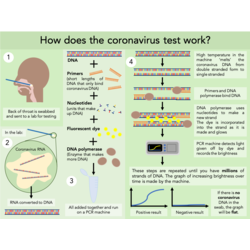By Ella Hopkins
After the success of my previous blog post on how the coronavirus makes us ill, I have decided to continue on the theme of explaining a coronavirus concept at increasing levels of difficulty.
So how exactly does this test work?
This process can be a bit complicated, so if you are more of a visual learner it may be better to look at the graphic I have made (here on Twitter).
Firstly, the coronavirus’ RNA, a chemical cousin of DNA, is converted to DNA. This is important as the PCR test only works with DNA. The DNA is mixed in a tube with all the other ingredients of the test – small lengths of DNA called ‘primers’, a protein called DNA polymerase, nucleotides (individual units that make up DNA) and a fluorescent dye. The tube with all the components is added to the PCR machine and the test is run.
There are 3 main steps that the machine does; firstly, it gets very hot and all the DNA in the tube splits from its normal double-stranded form, to a single-stranded form. This step is called ‘melting’.
The second step involves the primers binding to the single-stranded DNA. Primers can only do this when DNA is in its single-stranded form, which is why the first step is so vital. These primers are very specific; they can only bind to the DNA made from the coronavirus and not any other DNA (such as DNA from our cells that the swab may have picked up).
Once the primers have attached to the DNA, the protein called DNA polymerase can bind to the DNA-primer complex and build a new strand using the nucleotides. This makes the DNA double stranded again. This process of melting the DNA, adding primers, and making more DNA is called a cycle and is repeated around 30 times. By the end of the test there are millions of strands of DNA.
But why is making lots of DNA important, you ask?
Well, this is where the fluorescent dye comes in handy. Whenever new strands of DNA are made, the fluorescent dye is included into the new strands and gives off more light than when it is not in the DNA. The PCR machine detects the increase in light over time and makes a curve on a graph.
So, in a swab with coronavirus, the amount of DNA will increase with each cycle and more light will be given off. The graph will show a curve – a positive result. In a swab with no coronavirus, no more DNA will be made and no light will be given off. This would lead to no curve appearing on the graph at all - a negative result.
It is important not to get a wrong result. Researchers have worked hard to make sure the primers only bind to coronavirus-derived DNA and not any other DNA. They have also made sure it binds well to all strains of this coronavirus. To rule out that the other chemicals in the test are faulty or that the PCR machine isn’t working properly, controls are run. There are two types of control, a positive control and a negative control. Put simply, a positive control should always give a result if the test is run correctly, and a negative control should never give a result. If these controls fail, the curves seen on the graph will be ignored and the test will be run again.
It is also crucially important to avoid cross-contamination between samples at any stage. As this is a very sensitive test, even a time amount of RNA from an infected individual could be enough to cause a wrong diagnosis in someone not infected. This is one of many reasons why it is vital for all healthcare workers to wear adequate PPE.
